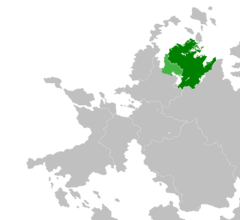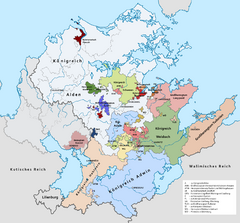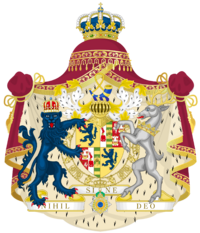Mascyllary Kingdom: Difference between revisions
mNo edit summary |
No edit summary |
||
| Line 95: | Line 95: | ||
|currency = Mascyllary gold mark (1793–1910)<br>Mascyllary ''Pappemark'' (1910–1918)<br>Mascyllary silver mark (1918–1923) | |currency = Mascyllary gold mark (1793–1910)<br>Mascyllary ''Pappemark'' (1910–1918)<br>Mascyllary silver mark (1918–1923) | ||
<!-- Titles and names of the first and last leaders and their deputies --> | <!-- Titles and names of the first and last leaders and their deputies --> | ||
|leader1 = | |leader1 = [[Monarchy of Mascylla#List|Lucas I]] | ||
|leader2 = | |leader2 = [[Monarchy of Mascylla#List|Louis I]] | ||
|leader3 = | |leader3 = | ||
|leader4 = | |leader4 = | ||
| Line 151: | Line 151: | ||
}} | }} | ||
The '''Mascyllary Kingdom''' ({{wp|German language|Hesurian}}: ''Maskillisches Königreich''), also inofficially known as the '''Kingdom of Mascylla''' ({{wp|German language|Hesurian}}: ''Königreich Maskillien''), was the [[Mascyllary people|Mascyllary]] {{wp|nation state}} that existed from the [[War of the Five Kings|unification of Mascylla]] in 1793 until [[Mascyllary Revolution|the abdication and execution]] of [[Monarchy of Mascylla|King | The '''Mascyllary Kingdom''' ({{wp|German language|Hesurian}}: ''Maskillisches Königreich''), also inofficially known as the '''Kingdom of Mascylla''' ({{wp|German language|Hesurian}}: ''Königreich Maskillien''), was the [[Mascyllary people|Mascyllary]] {{wp|nation state}} that existed from the [[War of the Five Kings|unification of Mascylla]] in 1793 until [[Mascyllary Revolution|the abdication and execution]] of [[Monarchy of Mascylla|King Louis I]] in 1923. The Mascyllary Kingdom was composed of 31 states, most of them had been ruled by a {{wp|dynasty|royal family}}. These included five {{wp|kingdom|kingdoms}}, six {{wp|grand duchy|grand duchies}}, four {{wp|duchy|duchies}}, fourteen {{wp|principality|principalities}}, and two {{wp|city state|independent cities}}. The unification and establishment of Mascylla was belatedly concluded with the Treaty of Langquaid signed on 18 May 1793 to end the fighting of the [[War of the Five Kings]], the subsequent proclamation of [[Kingdom of Aldia|Aldian king]] [[Monarchy of Mascylla#List|Lucas I]] as [[Monarchy of Mascylla|King of Mascylla]] in Langquaid on 23 May, and the adoption of the [[Constitution of Mascylla]] on 17 April 1796. On the basis of the hegemony of the [[House of Ahnern]] over Mascylla as a whole and the exclusion of [[Kingdom of Adwhin|Adwhin]] from supranational power, the Mascyllary Kingdom was the first Mascyllary {{wp|nation state}} in history. | ||
The kingdom saw a major and gradual transformation of society and economy owed to the {{wp|Industrial Revolution}}, while it socially and structually began to reform itself from an {{wp|agrarian society|agrarian state}} to an {{wp|industrial nation}}, with significant service, banking and manufacturing sectors and a steadily growing economy (colloquially dubbed the ''Gründerjahre''). The increasing emancipation of the growing middle class of entrepeneurs and politically active citizens prompted social reforms such as increased {{wp|globalism|global trading}}, {{wp|suffrage}} and {{wp|socialism}} as political directive of the rising {{wp|worker class}}. Structural basis of these developments include a rapid {{wp|population growth}}, {{wp|human migration|large migration}} and {{wp|urbanisation}}. | The kingdom saw a major and gradual transformation of society and economy owed to the {{wp|Industrial Revolution}}, while it socially and structually began to reform itself from an {{wp|agrarian society|agrarian state}} to an {{wp|industrial nation}}, with significant service, banking and manufacturing sectors and a steadily growing economy (colloquially dubbed the ''Gründerjahre''). The increasing emancipation of the growing middle class of entrepeneurs and politically active citizens prompted social reforms such as increased {{wp|globalism|global trading}}, {{wp|suffrage}} and {{wp|socialism}} as political directive of the rising {{wp|worker class}}. Structural basis of these developments include a rapid {{wp|population growth}}, {{wp|human migration|large migration}} and {{wp|urbanisation}}. | ||
The development of domestic and foreign policy was dominated by the fallout of the [[Second Cutho-Mascyllary War]] of 1839-41 and worsening [[Cuthish–Mascyllary enmity|enmity to Cuthland]]. Succeeding prime ministers and kings, most notably King | The development of domestic and foreign policy was dominated by the fallout of the [[Second Cutho-Mascyllary War]] of 1839-41 and worsening [[Cuthish–Mascyllary enmity|enmity to Cuthland]]. Succeeding prime ministers and kings, most notably King [[Monarchy of Mascylla#List|Louis I]], designed an intricate international network of {{wp|political alliance|alliances}} with [[Lavaria]] and later [[Falland]], similar to Wilhelm von Stenreck's original foreign policy in the 1830s abolished by the more ambitious [[Monarchy of Mascylla#List|Lucas II]], which sought to combat the [[Central Alliance (Aurorum)|Central Alliance]]'s powers of [[Second Cuthish Empire|Cuthland]] and [[Dulebian Empire|Dulebia]] in Berea. While the alliances were supposed to ensure peace among major powers, Louis I intensified the role of Mascylla as a global and {{wp|imperialism|imperialist}} power, vying to regain lost territories from Cuthland as {{wp|ravanchism}} and expand its [[Mascyllary colonial empire|colonial empire]] in overseas. International conflicts of interest arose quickly and laid the foundations of the later [[Great War (Aurorum)|Great War]]. | ||
The rise of {{wp|labour union|labour unions}} and popular {{wp|political party|parties}} precipitated the liberalisation of the {{wp|press}} and the growing importance of popular opinion in politics. Because of that, the government tried persuading and assuring the public through an imperialist foreign policy, a notably anti-{{wp|social democracy|social democratic}} internal policy and a popular expansion of naval forces (''Reichsmarine''). These interests found themselves at odds with Cuthish and [[Dulebian Empire]], the latter of which being alienated by Mascylla's action despite their historic friendship through the rule of the [[House of Loxstedt-Hoeveden|Ahnern-Loxstedt-Hoeveden-Zhdanovy monarchy]] in Dulebia since the 1870s. The Great War was greatly exhausting and the eventual victory in 1916 came at a great cost in human and economic resources. The ratification of the [[Treaty of Lehpold]] in 1917 allowed Mascylla to reclaim its territories lost in 1841, pressure Cuthland into enormous {{wp|war reparations}} and solidify itself as a forefront global {{wp|great power}}. The Mascyllary colonial empire reached its territorial zenith by the begin of the 1920s, but the gradual rise of military influence on internal policy and the effects of intense warfare caused social and eventually political upheavel. | |||
The [[Crowned Republic of Mascylla|Crowned Republic]] and the abdication of Louis I were declared during the [[Mascyllary Revolution|October Revolution of 1923]] and intense political and societal clashes and infighting. The National Assembly at Weidenau in 1924 constituted the kingdom as a {{wp|parliamentary system|parliamentary}} {{wp|constitutional monarchy}}. Present Mascylla is identical to the Mascyllary Kingdom of 1793 according to {{wp|international law}}, even though its {{wp|form of government}} and territory have changed multiple times since. | |||
==History== | ==History== | ||
Revision as of 08:18, 14 November 2021
Mascyllary Kingdom Maskillisches Königreich (Hesurian) | |
|---|---|
| 1793–1924 | |
Motto: Vereint in Blut und Ehre "United in blood and honour" Nihil sine Deo "Nothing without God" (Cambran) | |
 The Mascyllary Kingdom on the eve of the Great War in green, territories lost after 1841 in light green | |
 | |
| Capital | Langquaid (1793-94) Königsreh (1794-) |
| Common languages | Official: Hesurian Unofficial: Cuthish Valimian Temarian Falian |
| Religion | Semitarism |
| Demonym(s) | Mascyllary |
| Government | Federal parliamentary semi-constitutional monarchy |
| King | |
• 1793–1827 (first) | Lucas I |
• 1892–1923 (last) | Louis I |
| Prime Minister | |
• 1793–1835 (first) | Wilhelm von Stenreck |
• 1922–1923 (last) | Erwin Martinsen |
| Legislature | Imperial Diet |
| Imperial Diet | |
| Federal Council | |
| Historical era | 1793–1923 |
| 23 May 1793 | |
• Constitution adopted | 17 April 1796 |
| 8 September 1910 | |
| 10 March 1917 | |
| 13 May 1923 | |
| 2 June 1923 | |
| 26 January 1924 | |
| Population | |
• 1800 | 6,800,000 |
• 1900 | 21,570,000 |
• 1909 | 23,720,000 |
• 1920 | 26,220,000 |
| Currency | Mascyllary gold mark (1793–1910) Mascyllary Pappemark (1910–1918) Mascyllary silver mark (1918–1923) |
| Today part of | |
The Mascyllary Kingdom (Hesurian: Maskillisches Königreich), also inofficially known as the Kingdom of Mascylla (Hesurian: Königreich Maskillien), was the Mascyllary nation state that existed from the unification of Mascylla in 1793 until the abdication and execution of King Louis I in 1923. The Mascyllary Kingdom was composed of 31 states, most of them had been ruled by a royal family. These included five kingdoms, six grand duchies, four duchies, fourteen principalities, and two independent cities. The unification and establishment of Mascylla was belatedly concluded with the Treaty of Langquaid signed on 18 May 1793 to end the fighting of the War of the Five Kings, the subsequent proclamation of Aldian king Lucas I as King of Mascylla in Langquaid on 23 May, and the adoption of the Constitution of Mascylla on 17 April 1796. On the basis of the hegemony of the House of Ahnern over Mascylla as a whole and the exclusion of Adwhin from supranational power, the Mascyllary Kingdom was the first Mascyllary nation state in history.
The kingdom saw a major and gradual transformation of society and economy owed to the Industrial Revolution, while it socially and structually began to reform itself from an agrarian state to an industrial nation, with significant service, banking and manufacturing sectors and a steadily growing economy (colloquially dubbed the Gründerjahre). The increasing emancipation of the growing middle class of entrepeneurs and politically active citizens prompted social reforms such as increased global trading, suffrage and socialism as political directive of the rising worker class. Structural basis of these developments include a rapid population growth, large migration and urbanisation.
The development of domestic and foreign policy was dominated by the fallout of the Second Cutho-Mascyllary War of 1839-41 and worsening enmity to Cuthland. Succeeding prime ministers and kings, most notably King Louis I, designed an intricate international network of alliances with Lavaria and later Falland, similar to Wilhelm von Stenreck's original foreign policy in the 1830s abolished by the more ambitious Lucas II, which sought to combat the Central Alliance's powers of Cuthland and Dulebia in Berea. While the alliances were supposed to ensure peace among major powers, Louis I intensified the role of Mascylla as a global and imperialist power, vying to regain lost territories from Cuthland as ravanchism and expand its colonial empire in overseas. International conflicts of interest arose quickly and laid the foundations of the later Great War.
The rise of labour unions and popular parties precipitated the liberalisation of the press and the growing importance of popular opinion in politics. Because of that, the government tried persuading and assuring the public through an imperialist foreign policy, a notably anti-social democratic internal policy and a popular expansion of naval forces (Reichsmarine). These interests found themselves at odds with Cuthish and Dulebian Empire, the latter of which being alienated by Mascylla's action despite their historic friendship through the rule of the Ahnern-Loxstedt-Hoeveden-Zhdanovy monarchy in Dulebia since the 1870s. The Great War was greatly exhausting and the eventual victory in 1916 came at a great cost in human and economic resources. The ratification of the Treaty of Lehpold in 1917 allowed Mascylla to reclaim its territories lost in 1841, pressure Cuthland into enormous war reparations and solidify itself as a forefront global great power. The Mascyllary colonial empire reached its territorial zenith by the begin of the 1920s, but the gradual rise of military influence on internal policy and the effects of intense warfare caused social and eventually political upheavel.
The Crowned Republic and the abdication of Louis I were declared during the October Revolution of 1923 and intense political and societal clashes and infighting. The National Assembly at Weidenau in 1924 constituted the kingdom as a parliamentary constitutional monarchy. Present Mascylla is identical to the Mascyllary Kingdom of 1793 according to international law, even though its form of government and territory have changed multiple times since.


